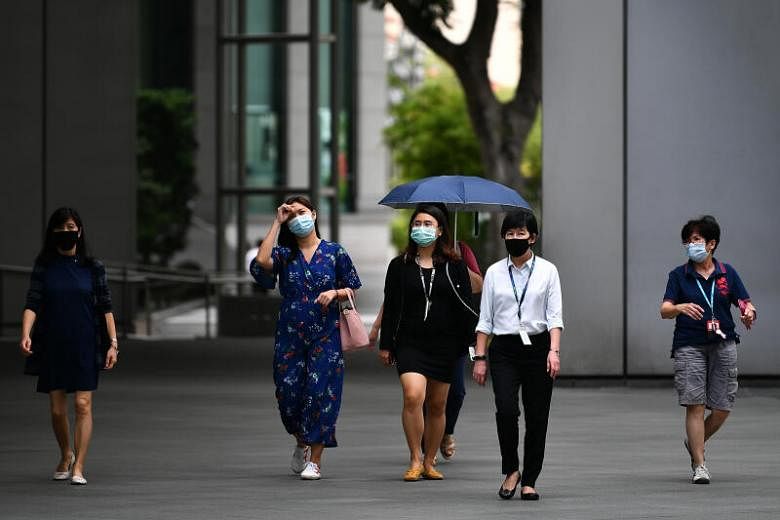SINGAPORE - The labour market is showing signs of strain as businesses put off recruitment amid the uncertainty brought about by Covid-19.
The hiring outlook among Singapore employers for the next quarter has reached the weakest level since 2009, according to a report released on Tuesday (June 9).
Out of 266 firms polled during the circuit breaker period, 38 per cent expect headcount to fall in the July to September quarter, compared with the current quarter, said the report by United States-based recruitment firm ManpowerGroup.
Another 11 per cent forecast an increase in headcount, while 46 per cent expect no change and 5 per cent are unsure.
The resulting net employment outlook is -28 per cent after accounting for seasonal variation. This is calculated by subtracting the percentage of employers anticipating total employment to fall from the percentage expecting to see an increase in employment at their location in the next quarter.
The net employment outlook figure for the next quarter is 37 percentage points lower than the figure that had been reported for this quarter and 40 percentage points lower than the figure for the third quarter of 2019.
ManpowerGroup Singapore country manager Linda Teo said most employers are putting non-critical hiring on hold and focusing on streamlining their current headcounts instead.
"Amid the bleak hiring climate, job seekers can still find pockets of opportunities, especially in the public administration and education sector due to ongoing government initiatives to stimulate hiring and upskilling during this challenging time.
"Job seekers finding difficulty in landing a job in current market conditions can consider upgrading their skills to better position themselves when hiring activity picks up," she said.
Deputy Prime Minister Heng Swee Keat said last week in his speech rounding up the debate on the supplementary Fortitude Budget that the number of unemployed residents is likely to exceed 100,000 this year. This would exceed the record number of 91,000 unemployed residents during the 2003 severe acute respiratory syndrome (Sars) epidemic.
Preliminary data from the Manpower Ministry released in April showed that total employment in Singapore, excluding maids, plunged by 19,900 in the first quarter. This was the sharpest quarterly contraction since Sars, and was due to the fall in foreign employment, while employment of residents - Singaporeans and permanent residents - still grew at a "modest pace", the ministry had said.
It will be releasing finalised figures for the first quarter on June 15.
The ManpowerGroup report said that Singapore's outlook for the third quarter is the worst among the 43 markets surveyed, although all 43 reported weaker hiring sentiment when compared with this time last year. The strongest hiring pace is anticipated in Japan (net employment outlook of 11 per cent), India (5 per cent), as well as the US, China and Taiwan (all 3 per cent).
Still, two-thirds (66 per cent) of Singapore employers polled expect hiring levels to return to pre-Covid-19 levels within the next 12 months. Some 20 per cent estimated this will happen within three months, while 15 per cent think it will take more than a year.
Employers in six of the seven sectors here expect payrolls to decline during the coming quarter. Construction and mining firms have the bleakest net employment outlook of -57 per cent after adjusting for seasonal variations, the weakest level since ManpowerGroup started conducting the survey here in 2003.
Services and manufacturing firms also see weak hiring prospects, with net employment outlook figures of -35 per cent and -21 per cent respectively. Wholesale and retail trade firms had a net employment outlook of -19 per cent.
The situation is less gloomy elsewhere with the finance, insurance and real estate sector expecting net employment outlook of -3 per cent while transport and utilities sectors are at -1 per cent.
The bright spot is the public administration and education sector, which reported modest hiring plans with a positive outlook of 10 per cent.
Out of the four business sizes - micro, small, medium and large - only micro enterprises with fewer than 10 employees had a net positive outlook on hiring.
Ms Teo noted: "With most companies putting non-essential hiring on hold, micro-sized firms face less competition in hiring the in-demand talent they need."
Separately, the American Chamber of Commerce in Singapore released preliminary findings on Tuesday from an annual manpower survey of member companies, conducted from April to May.
It found that 17 per cent of 110 senior executives said they would trim jobs in the medium term to save costs while 76 per cent expect no change to headcount. The remaining 7 per cent plan to expand and hire more.
The report also noted that 20 per cent of multinationals plan to trim jobs here in the medium term while 12 per cent of small- and medium-sized enterprises expect to do so.
Weaker hiring sentiment was also reported by job portal operator JobStreet on Tuesday. It said that job ads have dropped significantly in industries such as aerospace; grooming, beauty and fitness; retail; food and beverage, catering and restaurant; and event management and meetings, incentives, conferences and exhibitions.
"The significant reduction in openings means current employees as well as recently displaced candidates in these industries now have to vie for a much smaller pool of jobs," the firm noted.
There was a 95 per cent drop in aerospace ads, resulting in an 81 per cent increase in applications per ad. Retail saw an 85 per cent drop in adverts but an 88 per cent increase in applications per ad.
On the other hand, there was a 41 per cent increase in job ads for security and law enforcement jobs, while science and technology posts recorded an increase of 20 per cent, with opportunities such as microbiologist, research fellow, laboratory technician and research assistant.
The top 10 industries actively hiring are: healthcare; education; banking and finance; government; computing and information technology; security and law enforcement; transportation and logistics; construction/building/engineering; manufacturing and production; and insurance.
Job seekers were most interested in admin, data entry, driver, marketing and accountant jobs, based on the top searched keywords in April, JobStreet said.
In particular, searches for data entry jobs spiked by 162 per cent, which could be because recently retrenched workers were looking for a quick temporary job that does not require specific industry knowledge, said the firm.
"With the circuit breaker coming into effect in April, data entry jobs allow retrenched workers to work from home and still earn salaries to help them tide over the difficult period," it added.
It said it has added a new function to job seekers' profiles where they can indicate #WorkNow if they are available to start work immediately. Potential employers with urgent hiring needs will be able to search for such profiles easily.












